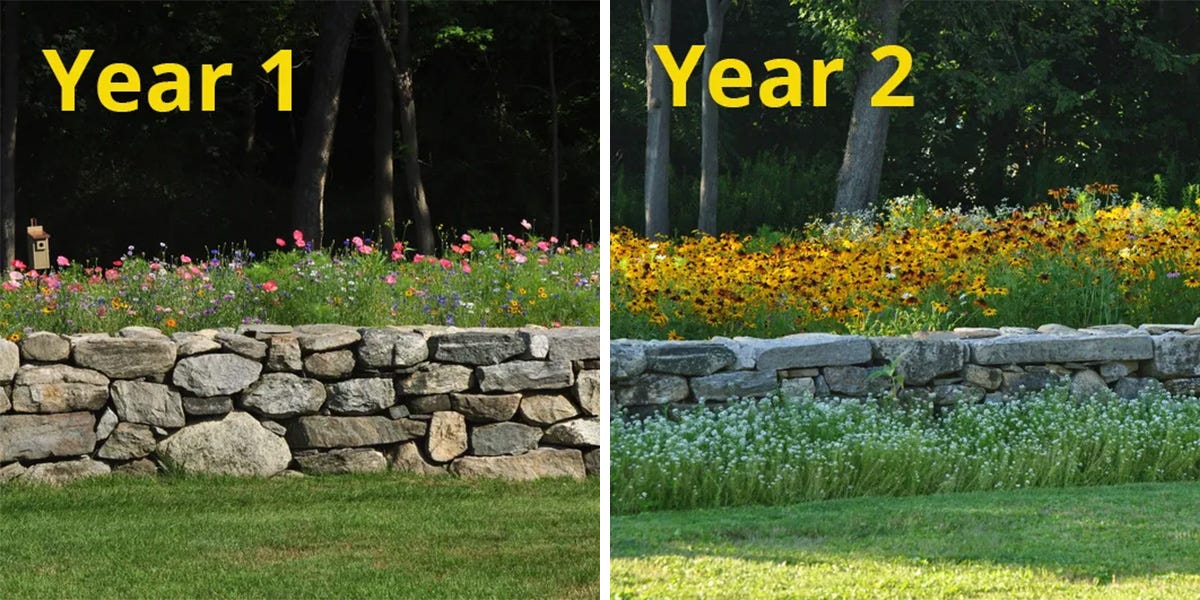Part Of The American Meadows Wildflower Learning Center
END OF SEASON MEADOW MAINTENANCE
Your beautiful wildflower meadow dazzled all season, but now the days are getting shorter and the growing season is coming to an end. Should you mow your meadow, or leave it standing? What can you expect after winter - will it grow back, or does it need to be reseeded? Follow this guide to learn the best practices for taking good care of your wildflower meadow.
Follow Along With More Of Our Guides


End Of Growing Season Meadow Maintenance: What To Expect
As the growing season comes to an end, many wildflowers with spent blooms will be sporting showy seed heads, and you may see birds stopping in the meadow to snack on the seeds.
Some wildflowers - especially annual wildflowers and late-blooming perennial wildflowers - may even tolerate the first light frosts and bloom all the way to a hard frost or freeze. You’re sure to see bees and pollinators filling up on pollen and nectar from these flowers as they prepare for winter.
Once your wildflowers have set seed, you may choose to collect some of these seeds to share with friends or reseed in your meadow or elsewhere in your yard.
Some wildflowers will die back completely over the winter. Others will have stiff stems that will stay upright over the winter. These stems and the organic matter in your meadow serve as habitat for overwintering pollinators and beneficial insects!


To Mow Or Not To Mow Your Wildflower Meadow
To mow or not to mow? It’s always a popular question! Wildflowers only need mowing once per year, at the most. There is not one perfect time to mow your wildflower meadow - you can determine a mowing schedule that works for you.
Read on to learn the pros and cons of mowing, spring vs fall mowing, and how to mow (if you mow).
Reasons To Mow
- For appearances: If you have HOA or aesthetic regulations for your home, you may need to mow to keep your property in compliance.
- To reduce weeds: if you have unwanted weeds in your meadow, be sure to cut them back before they go to seed.
- To disperse seeds: mowing can help wildflower seeds from your flowers make contact with the soil and increase their chance of germination.
- To remove diseased foliage: if your wildflower foliage had fungal or mildew growth, it’s best to cut down the stems and dispose of them so that the diseases don’t proliferate in your soil.
- Looking for a mowing compromise? Adopt a looser mowing schedule. Some mow every other year. Some mow alternating sections of meadow every year. Some mow only the edges of a meadow.
- In a large meadow, you can mow walking pathways to enjoy being immersed in a sea of blooms!
Reasons Not To Mow
- For pollinators: Moths, butterflies, solitary native bees, hoverflies, ladybugs, and other pollinators and beneficial insects overwinter in plant debris. Leaving your meadow standing will help protect their winter habitats! This population forms the bottom of the food chain, feeding birds and other wildlife too.
- For birds: wildflower seed heads provide an important source of fat for birds, helping them fuel up for cold winter months.
- For winter interest: sculptural stems and spiky or fluffy seed heads look beautiful with a dusting of snow!
- For insulation: leaving plants standing will help protect the crown of perennial plants, and help protect perennial root systems from the harshest winter weather.
- Save time, money, and resources: skipping mowing removes one more list from your to-do list, and you’ll save fuel and reduce pollution by not using motor-powered mowing tools.
When To Mow Your Wildflower Meadow
- If you decide to mow your meadow, mow in fall or spring:
- In fall, mow after your wildflowers have gone to seed.
- If you have weeds in your meadow, be sure to cut those back before they go to seed. You can mow a section of your meadow if the weeds are clustered, or walk through your meadow to cut the weeds by hand.
- In spring, wait to mow your meadow until daytime temperatures have reached 50°F consistently. This will allow the pollinators and beneficial insects hibernating in your meadow a chance to wake up for the season.
How To Mow Your Wildflower Meadow
- Use a string trimmer to cut down your wildflowers, or use a lawn mower, brush hog, or tractor with a mower deck set to the highest setting.
- If you mow in fall, leave the clippings (of disease-free foliage) in place to break down and feed the soil.
- If you mow in spring, rake the clippings and debris. Raking away the clippings will open things up at ground level, which allows sunlight to penetrate young perennial plants. You'll likely be amazed by the young wildflower seedlings that you find ready to grow so early in the season.


Wildflower Dormancy & Overwintering
What to expect with overwintering depends on the lifecycle of the flowers in your meadow.
- Annuals have a one year lifecycle. They put all of their energy into blooming, attracting pollinators, and producing seed in their one year of life. At the end of the growing season, annual wildflowers will die.
- Perennials live for many years, returning year after year from the same root system. These plants go dormant over the winter. Some may have foliage above ground that you can see over the winter, but some may die back completely, with only roots snug below ground to overwinter.
- Biennials have a two year life cycle. After their first growing season, they will overwinter with their root system dormant underground. After the second growing season, they will die.
Learn More: The Life Cycles Of Annuals, Perennials & Biennials
How do you know what’s in your wildflower meadow? All of our wildflower seed mixes include a mix of annuals and perennials - with the exception being any wildflower seed mix with “Annual” in the name. See “What’s In This Mix” on the product page for your wildflower seeds.
How do you know what’s in your wildflower meadow? All of our wildflower seed mixes include a mix of annuals and perennials - with the exception being any wildflower seed mix with “Annual” in the name. See “What’s In This Mix” on the product page for a list of the species in your wildflower seed mix.


What To Do When Your Wildflower Meadow Grows Back
Why does your meadow look different in year two or three than it did in the first year? Changes can occur as the wildflowers in the meadow adapt to growing conditions. You can also add to your meadow to give it a boost of color.
Meadow Lifecycles Year 1, 2, 3 & Beyond
Changes in blooms are also a result of the lifecycle of the wildflowers in your meadow. When you plant a wildflower seed mix that contains annual, perennial, and biennial wildflower species, like many of our mixes from American Meadows, here is what you can expect from the life cycle of your meadow.
Year 1
- Annual wildflowers bloom until frost
- Perennials and biennials typically just grow foliage and establish a root system.
Year 2
- Annual wildflowers are most likely gone or significantly reduced, especially in climates with cold winters - this can sometimes be known as the "Sophomore Slump" in a meadow. Depending on the species and your growing conditions, some annuals may reseed in your meadow and bloom in the second or subsequent seasons. We recommend sowing fresh annual seeds every year.
- Perennials will return from their established root system. Some will be ready to bloom, but others may not be fully mature and blooming at full potential.
- Biennials also return from their established root systems and fill in your meadow with color in the second season.
Year 3 & Beyond...
- Perennials will be taking over and reaching their full potential, offering shifting colors and abundant blooms.
- Some annuals and biennials may have reseeded, but most will have passed.
- Over time, if you want to layer in additional color, you always have the option to plant new wildflower seeds into your established meadow.
Learn More: The Life Cycles Of Annuals, Perennials & Biennials
Meadow Lifecycles Year 1, 2, 3 & Beyond
If you want to fill bare patches in your meadow, add more color or more variety into your meadow, or expand your meadow, this guide will show you how.
Learn More: How To Add To Your Established Meadow


Long-Term Meadow Care
Watching Wildlife
You'll notice small wildlife, many birds, butterflies, and other insects are attracted to your wildflower meadow. Observing these visitors is one of the great pleasures of meadowscaping. Over time you can add enhancements to your meadow, including mowing paths through your meadow, adding chairs or benches for observation, and adding bird feeders or birdhouses to encourage flying friends to call your meadow home. Enjoy it all for years to come!
Cut Flowers & Deadheading to Encourage Blooms
'Deadheading' is the practice of cutting back spent flower blooms. This helps to keep your plants looking fresh and healthy throughout the season. Additionally, when you cut back dead and dying flowers, you're sending a signal to the plant that it should focus its energy on producing even more blooms. While you’re deadheading, it’s another chance to cut a fresh flower bouquet, too!
Natural Succession
Eventually, you may see wildflowers that were not part of your mix, or even tree and brush seedlings, creep into any open field over time. These can be removed selectively with hand tools instead of mowing, or they can be allowed to grow, or they can be transplanted to another part of your yard.
Reminders From Our Wildflower Planting Guide: Wildflowers Vs. Weeds
- We do not recommend using chemical sprays, as you'll risk accidentally spraying the plants you'd like to see growing. Further, many important pollinators and other beneficial insects are likely to get caught in the crossfire.
- If you planted your meadow where there was regularly mown lawn, there is often less weed pressure and fewer weed seeds in the soil. On the other hand, if you planted in a rural or agricultural setting, or in an area that was not mowed regularly, there can be a large amount of weed seeds dormant in your soil, and you may need to do extra weeding as your wildflower meadow establishes.
- Wondering, "Are those wildflowers or weeds?” When in doubt, do not pull the plant. If you give your seedlings some time to grow, you may find that they were wildflowers all along.
- If you do identify a weed, you can gently pull it up from the ground, careful not to disturb surrounding plants or seedlings. Or, cut it back before it goes to seed. Just lean in and snip as low down on the weed plant as you can. A few passes with your scissors every week or two will greatly reduce the threat of weeds proliferating in your meadow.
Expert Tips For Weeding:
- Have fun with weeding! Bring a friend and a glass of wine so you can Snip n' Sip your way through the wildflowers. While you’re at it, you can cut some stems for a bouquet, too.
- Research and learn about your local weeds at every stage of growth. Getting to know what they look like as seedlings, adolescent, and adult plants will make it easier to spot them within your plantings.
- Try using a plant identification app to learn more about the wildflowers and plants growing in your yard and your neighborhood.
More From Our Learning Center




